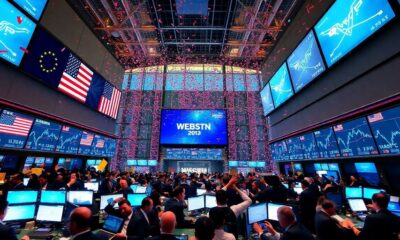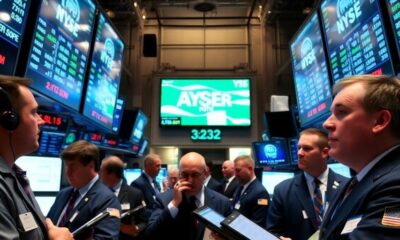Economy
Economy News Analysis: Understanding Global Markets and Economic Shifts

In today’s world, understanding the economy is crucial. This article explores different aspects of global markets, focusing on how various countries are adapting to changes. We will look at the U.S., China, Europe, and other regions to see how they are dealing with economic challenges and opportunities.
Key Takeaways
- The U.S. job market is stronger than expected, boosting consumer confidence.
- China is facing a property crisis but is working on stimulus measures to support its economy.
- Europe is struggling with inflation and growth disparities among countries.
- Global manufacturing is facing challenges, impacting trade and supply chains.
- Emerging markets are experiencing currency fluctuations and growth risks, but also investment opportunities.
Analyzing the US Economy
Impact of Presidential Elections on Trade
The upcoming presidential elections in the U.S. can significantly influence trade policies. Trade agreements may shift depending on the elected leader’s stance, affecting both imports and exports. For instance, the U.S. Bureau of Economic Analysis (BEA) reported that in 2023, U.S. exports of services reached $1,026.6 billion, while imports were $748.2 billion. This data highlights the importance of trade in the U.S. economy.
Federal Reserve’s Interest Rate Decisions
The Federal Reserve plays a crucial role in shaping the economy through its interest rate decisions. Recently, strong job growth has led many to believe that the Fed might be more cautious in cutting rates. The 10-year breakeven rate, an indicator of inflation expectations, has risen from 2.02% to 2.21% in just a few weeks, reflecting investor confidence in the economy.
Consumer Spending and Household Income
Consumer spending is a vital part of the U.S. economy. Recent reports show that household income has been growing, albeit modestly. This increase in income supports consumer spending, which is essential for economic growth. The latest data indicates that average hourly earnings have risen by 4% compared to last year, suggesting that the job market is tightening.
Job Market Trends
The job market in the U.S. is showing unexpected strength. In September 2024, 254,000 new jobs were created, marking a significant increase. This growth has led to a drop in the unemployment rate from 4.2% to 4.1%. The diverse job creation across sectors, especially in healthcare and leisure, indicates a resilient economy.
The U.S. economy is on a path toward a soft landing, but the journey may be less gentle than previously thought.
Overall, the U.S. economy is navigating through various challenges and opportunities, with the job market and consumer spending playing pivotal roles in its future.
China’s Economic Landscape
Property Market Crisis
China is facing a serious property market crisis. Many homes remain unsold, leading to financial troubles for companies involved in real estate. This situation is causing a balance-sheet recession, where businesses struggle to stay afloat due to unsold properties.
Government Stimulus Measures
In response to the slowing economy, the Chinese government has introduced various stimulus measures. These include cutting interest rates to encourage spending and investment. However, experts warn that it may take more than just these measures to revive the economy fully.
Consumer Confidence and Spending
Consumer confidence in China has been shaky. Many people are hesitant to spend, which is affecting overall economic growth. The government is trying to boost this confidence through various initiatives, but the results are still uncertain.
Impact of Global Trade Policies
Global trade policies are also affecting China’s economy. Tariffs and trade restrictions from other countries can hurt Chinese exports. This situation makes it crucial for China to adapt its strategies to maintain its economic growth.
The current economic landscape in China shows that while there are efforts to stimulate growth, the challenges are significant and require careful management.
| Economic Indicator | Current Status |
|---|---|
| Property Sales Decline (%) | 20% |
| Consumer Confidence Index | 45 (low) |
| Interest Rate (Current) | 3.5% |
| GDP Growth Rate (Forecast) | 4.5% |
European Economic Challenges
Inflation and Monetary Policies
Inflation in Europe has been a major concern, with rates fluctuating significantly. In September 2024, inflation dropped to 1.8%, which is below the European Central Bank’s target of 2%. This decline is a relief, but the central bank remains cautious about cutting interest rates too quickly.
| Month | Inflation Rate (%) | Core Inflation Rate (%) |
|---|---|---|
| September | 1.8 | 2.7 |
| August | 2.0 | 2.9 |
| July | 2.5 | 3.1 |
Economic Growth Disparities
Different countries in Europe are experiencing varying levels of economic growth. For instance, while some nations are recovering, others are still struggling. The economic makeup of Europe shows significant deficiencies, as highlighted in the Draghi report. This disparity can lead to tensions among member states, affecting overall stability.
Green Trade Restrictions
Europe’s green trade restrictions have sparked frustration among poorer countries. These policies often make it harder for them to compete in the global market. The impact of these restrictions is felt most by those who can least afford it, raising questions about fairness and equity in trade.
Impact of Political Uncertainty
Political uncertainty continues to loom over Europe, affecting investor confidence. With upcoming elections and shifting policies, many are left wondering how these changes will influence the economy. The fragile situation requires careful navigation to avoid further economic downturns.
The challenges facing Europe are complex and interconnected, requiring a coordinated response to foster stability and growth.
Global Manufacturing and Trade
Trends in Global Manufacturing
The global manufacturing sector is facing significant challenges. The Purchasing Managers’ Index (PMI), which measures the health of the manufacturing sector, dropped from 49.6 in August to 48.8 in September. This decline indicates a worsening situation, as most countries are now below the growth threshold of 50. Only a few countries, like India and the Philippines, are showing signs of growth.
Impact of Trade Wars
Trade wars have created uncertainty in global markets. Countries involved in these disputes often see their manufacturing sectors suffer. For instance, the U.S. manufacturing PMI fell to 47.3, reflecting a slowdown in production and new orders. This situation has led to job losses and a pause in investments, as companies are hesitant to commit resources amid ongoing tensions.
Supply Chain Disruptions
Supply chain issues continue to plague manufacturers worldwide. Delays and shortages have become common, making it difficult for companies to meet demand. The eurozone, particularly Germany, has been hit hard, with its PMI dropping to a concerning 40.6. This decline signals a significant contraction in manufacturing activity, raising alarms about future economic stability.
Future of Global Trade Agreements
Looking ahead, the future of global trade agreements remains uncertain. As countries navigate through these economic challenges, the need for cooperation and new agreements becomes more critical. The global economy relies heavily on trade, and any disruptions can have far-reaching effects.
The current state of global manufacturing highlights the interconnectedness of economies. As one region struggles, it can impact others, emphasizing the need for a collaborative approach to trade and economic policies.
Emerging Markets and Economic Stability

Currency Fluctuations and IMF Policies
Emerging markets often face challenges with currency fluctuations, which can lead to instability. These changes can affect everything from inflation rates to foreign investment. The International Monetary Fund (IMF) plays a crucial role in providing support to these countries, helping them stabilize their economies during tough times.
Growth Forecasts and Risks
Recent forecasts suggest that many emerging markets are expected to grow, but risks remain. For instance, geopolitical tensions and trade disputes can hinder progress. The table below shows projected growth rates for selected emerging markets:
| Country | Projected Growth Rate (%) |
|---|---|
| India | 6.5 |
| Brazil | 3.0 |
| South Africa | 2.5 |
| Indonesia | 5.0 |
Impact of Political Changes
Political changes can significantly impact economic stability in emerging markets. A new government can lead to shifts in policies that either promote growth or create uncertainty.
Investment Opportunities and Challenges
Investors often look to emerging markets for opportunities, but they must also be aware of the challenges. Understanding local conditions and market dynamics is essential for success.
Emerging markets can be a double-edged sword; they offer great potential but come with risks that require careful navigation.
In conclusion, while emerging markets present exciting opportunities, they also demand a keen understanding of the economic landscape and the influence of global factors, including tech reviews that can shape market perceptions.
Central Banks and Monetary Policies
US Federal Reserve Strategies
The Federal Reserve plays a crucial role in the U.S. economy by adjusting interest rates to influence economic growth and inflation. When the economy is strong, the Fed may raise rates to prevent overheating. Conversely, during downturns, lowering rates can stimulate spending and investment. This balancing act is essential for maintaining economic stability.
European Central Bank Policies
In Europe, the European Central Bank (ECB) has been cautious in its approach. With inflation recently dropping below the 2% target, the ECB is considering gradual rate cuts. However, they must be careful not to trigger inflation again. The current economic climate requires a delicate balance between supporting growth and controlling prices.
Bank of Japan’s Monetary Easing
The Bank of Japan (BOJ) has been in a prolonged period of monetary easing. Recently, they have started to tighten policies slightly, but the pace is slow to avoid harming the fragile economy. The BOJ aims to support the yen while ensuring that the economy does not suffer from rapid changes in interest rates.
Future of Global Interest Rates
Looking ahead, central banks worldwide may need to adjust their strategies more frequently. Geopolitical tensions and climate change are causing economic shocks that could lead to more volatile inflation. If central banks do not respond effectively, we might enter a period of higher inflation that could affect global markets significantly.
Central banks influence economic growth and inflation by using monetary policy tools to maintain economic conditions within an economy.
| Central Bank | Current Interest Rate | Recent Actions |
|---|---|---|
| US Federal Reserve | 5.25% | Gradual rate hikes |
| European Central Bank | 1.75% | Slow rate cuts |
| Bank of Japan | 0.25% | Tightening monetary policy cautiously |
This table summarizes the current interest rates and recent actions of major central banks, highlighting their strategies in response to economic conditions.
Technological Advancements and Economic Impact

Role of AI in Economic Growth
Artificial Intelligence (AI) is changing how businesses operate. AI helps companies become more efficient by automating tasks and analyzing data quickly. This leads to better decision-making and increased productivity. For example, companies using AI can reduce costs and improve customer service, which boosts their profits.
Impact of Technological Disruptions
Technological changes can disrupt traditional industries. When new technologies emerge, some jobs may disappear, while new ones are created. This shift can lead to economic growth but also requires workers to adapt. The economy must be flexible to handle these changes effectively.
Investment in Tech Industries
Investing in technology is crucial for economic development. Countries that invest in tech see faster growth. For instance, the table below shows how investment in technology correlates with GDP growth in various countries:
| Country | Tech Investment (% of GDP) | GDP Growth Rate (%) |
|---|---|---|
| USA | 3.5 | 2.8 |
| China | 4.0 | 5.5 |
| Germany | 2.8 | 1.5 |
Future of Work and Automation
Automation is changing the job market. Many jobs will require new skills, and workers must be ready to learn. The future of work will be shaped by technology, and education systems need to adapt to prepare students for these changes.
The impact of technology on the economy is profound. It not only drives growth but also reshapes how we work and live. Understanding these changes is essential for future success.
In summary, technological advancements play a vital role in shaping the economy. They create opportunities for growth but also present challenges that need to be addressed.
Conclusion
In summary, understanding the global economy is essential for everyone. As we see changes in job markets, inflation rates, and consumer spending, it becomes clear that these factors affect our daily lives. The U.S. job market is doing better than many expected, while Europe faces challenges with slow growth. Countries like China are trying to boost their economies by encouraging spending. As we move forward, keeping an eye on these trends will help us navigate the ups and downs of the economy. By staying informed, we can better prepare for what lies ahead.
Frequently Asked Questions
How do presidential elections affect trade in the US?
Presidential elections can change trade policies, which might impact how businesses buy and sell with other countries.
What does the Federal Reserve do with interest rates?
The Federal Reserve sets interest rates to help control inflation and support the economy. Lower rates can encourage spending, while higher rates can help slow down inflation.
How does consumer spending influence the economy?
When people spend more money, businesses earn more. This can lead to more jobs and a stronger economy.
What are the main challenges in China’s economy?
China is facing issues like a falling property market and worries about consumer spending, which can slow down its growth.
What is causing economic challenges in Europe?
Europe is dealing with high prices and different rates of growth across countries, which makes it hard for some areas to keep up.
How do technological advancements affect jobs?
New technologies can create new jobs but may also replace some existing jobs, changing how people work.
-

 Press Release6 days ago
Press Release6 days agoCrypto WINNAZ Launches First On-Chain Yield Engine for Meme Coins, Enabling 20x–300x Returns
-

 Press Release3 days ago
Press Release3 days agoBellarium ($BEL) Price Prediction: Could It Hit $5 by 2026?
-

 Press Release1 day ago
Press Release1 day agoPreventive Vaccines Market to Witness Strong Growth by 2035
-

 Press Release15 hours ago
Press Release15 hours agoClinical Trials Market Set for Robust Growth, Driven by Drug Development Surge and Digital Innovation
-

 Business3 days ago
Business3 days agoHow Managed IT Solutions Help Small Teams Compete at Enterprise Scale
-

 Press Release2 days ago
Press Release2 days agoFill-Finish Pharmaceutical Contract Manufacturing Market Expected to Flourish Amid Biopharmaceutical Boom and Global Outsourcing Trend by 2035
-

 Press Release2 days ago
Press Release2 days agoGreen Bio Chemicals Market Poised for Sustainable Growth amidst Global Shift to Eco-Friendly Alternatives by 2035
-

 Press Release2 days ago
Press Release2 days agoIndustrial Boiler Market Expected to Surpass USD 24.4 Billion by 2035 Amid Growing Demand for Energy Efficiency and Industrialization






























